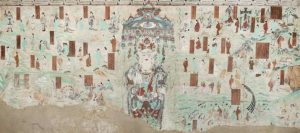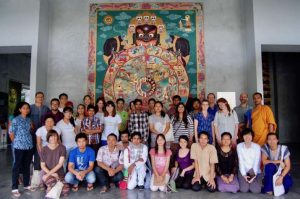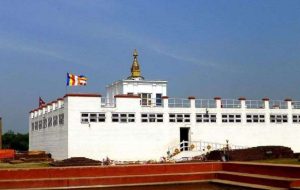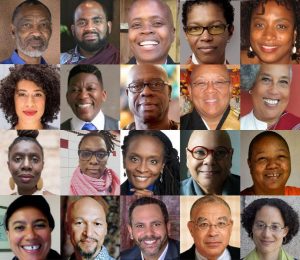
In his great wisdom, Master Shandao presented us with four scenarios of doubt that may impair or even destroy a Pure Land practitioner’s faith when they are challenged by others. He also indicated that these scenarios present an opportunity for Pure Land devotees to establish deep faith, if they can stand firm in the face of these challenges. Thus, these four scenarios become an effective yardstick for measuring the depth of a practitioner’s faith.
In the first scenario, the practitioner is aggressively challenged by monastics and householders holding different views on the Pure Land teaching. They interpret the Pure Land Dharma through the lens of other Buddhist sutras rather than the Pure Land sutras. They also believe that a common mortal with worldly passions is not able to attain rebirth in a Pure Land, or be reborn through exclusive practice of Amitabha-recitation.
Many Pure Land practitioners come across this awkward situation in the course of their association with other Buddhists. As discussed in my last article, Master Shandao gave an exemplary answer for handling this situation, so that one’s faith in Amitabha’s deliverance is reinforced afterwards.
The second scenario of doubt
Master Shandao writes about the second scenario of doubt:
The [Pure Land] practitioner can further tell [his challenger]:
“Sir, listen attentively! I will now reveal to you the firmness of my determinant faith. Should there be bodhisattvas who have not reached the first stage, arhats, and pratyekabuddhas, numerous enough to fill the Ten Directions; and should they all be quoting sutras and commentaries to prove that I cannot be reborn, I would not give rise to a single thought of doubt. In fact, I would strive all the more to deepen and perfect my faith [in rebirth].
“Why is this so? It is because the Buddha’s words are the ultimate, final, and perfect teaching, and nothing whatsoever can overcome them.”
This may seem a presumptive scenario for many Pure Land practitioners, as bodhisattvas, arhats, and pratyekabuddhas are sagely beings that are seldom seen nowadays. In addition, they are enlightened beings that see the nature of reality and can liberate themselves from samsara (rebirth in the Six Realms). Thus, their knowledge of birth and death is far advanced to that of ordinary beings, and their credibility is much higher than the monastics and laypeople in the first scenario (see my previous article in this series on faith).
However, the teachings of bodhisattvas, arhats, and pratyekabuddhas are simply beyond the capacities of ordinary beings living in the Saha world of the Dharma-ending age. Perhaps a few ordinary beings may understand the profundities of the Buddhist teachings, but it doesn’t mean they can practice the meditative or non-meditative virtues. Even if some of them can practice, it doesn’t mean they can achieve any results, and even if one or two achieve a result, it doesn’t mean they can help others do the same. Moreover, their wisdom and virtue are far from perfect when compared to the Buddha’s. No matter what these hypothetical bodhisattvas, arhats, and pratyekabuddhas say, ordinary beings can only rely on the Pure Land gate for liberation in this lifetime.
In this scenario, if the words of these sages have no effect on your faith in Amitabha’s vows of deliverance—that is, if you remain confident in your rebirth in the Land of Bliss through exclusive Amitabha-recitation—you are deemed to have pure faith in the Buddha’s words, which cannot be overcome or destroyed by anything whatsoever.
The third scenario of doubt
Concerning the third scenario of doubt, Master Shandao writes:
“Moreover, sir, listen attentively! Should bodhisattvas of the first stage or above, up to the tenth stage, fill the Ten Directions of space and unanimously proclaim it false that Shakyamuni Buddha singled out and praised the Buddha Amitabha; false that he scorned the Three Domains and Six Realms; false that he encouraged us to exclusively recite Amitabha’s name, and to practice other virtues that we might be reborn in [Amitabha’s] land after this lifetime; still, I would not be swayed. Hearing such words, I would not give rise to a single thought of doubt, but strive to deepen and perfect the supreme faith [in rebirth].
“Why is this? It is because the Buddha’s words are the ultimate, final, and perfect teaching. The Buddha is truthful in speech, truthful in interpretation, truthful in views, and truthful in accomplishment. None of his words were spoken with a delusive or doubtful mind. Furthermore, the Buddha’s teaching cannot be hindered by bodhisattvas with differing views and interpretations. If indeed they were true bodhisattvas, their words would not contradict the Buddha’s teaching.”
This, too, is a presumptuous scenario for many Pure Land practitioners, because the “challengers” are even higher in status—bodhisattvas of the first stage or above up to the 10th stage, and higher in knowledge and credibility.
Nowadays, many people claim to be bodhisattvas of a certain stage that can deliver all sentient beings in a great cosmos like the Saha world. However, strictly speaking, Nagarjuna Bodhisattva is the only bodhisattva of the first stage in recorded history. Indeed, his birth was prophesied in one of the sutras, and he is known today as “the second Shaykamuni.” Who could realistically claim a status comparable to or higher than Nagarjuna?
Nagarjuna is the founder of the Eight Great Sects, including the Pure Land sect. In his Chapter on Easy Practice, he says, “Amitabha’s Fundamental Vow is as follows: If anyone invokes me, recites my name, and takes refuge in me, he will instantly enter the state of assurance [non-retrogression] and subsequently attain the highest perfect enlightenment. For this reason, you should always be mindful of Amitabha Buddha.”
That is why Master Shandao says: If they [bodhisattvas of the first stage or above, up to the 10th stage] were true bodhisattvas, their words would not contradict the Buddha’s teaching. All bodhisattvas must follow strictly what the Buddha teaches in the sutras, and explain correctly the meaning of his teachings.
We will discuss the fourth scenario of doubt in the next article.
Related features from Buddhistdoor Global
Master Shandao’s Exegesis on the Deep Mind—The Four Scenarios of Doubt: Part I
Cutting through the Delusive Mind with Faith in Amitabha’s Deliverance
Establishing Deep Faith in Amitabha’s Deliverance in the Context of a Person (the Buddha)











